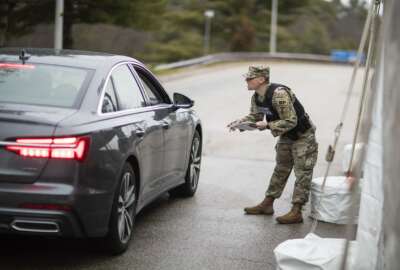
Board recommends eliminating DoD CMO’s office, replacing it with one of 3 options
An independent assessment by the Defense Business Board found DoD's chief management officer is “nearly unanimously” viewed as ineffective — partly because...
The DoD Reporter’s Notebook is a weekly summary of personnel, acquisition, technology and management stories that may have fallen below your radar during the past week, but are nonetheless important. It’s compiled and published each Monday by Federal News Network DoD reporters Jared Serbu and Scott Maucione.
DBB: Pentagon needs top-level official for business reform, but CMO isn’t it
A new Congressionally-mandated independent assessment by the Defense Business Board found the Defense Department’s chief management officer is “nearly unanimously” viewed by leaders in and out of the Pentagon as ineffective — partly because the CMO was never set up for success.
The DBB based its conclusions on interviews with 90 people, most of whom are current or former senior Defense officials. Among the findings are that the CMO position, and the deputy CMO one that came before it, have been handicapped by acting leadership. Since 2008, it’s had a Senate-confirmed leader only 45% of the time.
The board found the CMO has not delivered on its mission of business transformation, mostly not because of the failings of any of its leaders, but because it’s lacked the authority to drive change. The authors noted that unlike the CMOs of the military services — the undersecretaries — the DoD CMO doesn’t control people, budgets or data. Without that, “DoD culture ‘ignores’ or ‘waits out’ transformational or budgetary changes,” they wrote.
“[Military service and agency] leaders often choose to not fully comply with transformative efforts, as the CMO has no leverage to compel their compliance or sometimes even their participation,” according to a summary of the report. “Only the deputy secretary of Defense can create compliance in reform for considerations elsewhere.”
So what to do? The board offered three different options for a new position that it believes should replace the CMO, and could drive real business reform:
- A new principal undersecretary of Defense for business transformation that would focus only on reform efforts. The CMO’s other duties, like overseeing various Defense agencies and regulatory functions would move elsewhere.
- Set up two deputy secretaries of Defense: One for resources and management, and one for strategy and policy.
- Give the deputy secretary the role of chief operating officer, but distribute the rest of the CMO’s roles to other DoD organizations, including the comptroller, the Office of Cost Assessment and Program Evaluation (CAPE), the chief information officer, and a new Performance Improvement Officer. The DBB said this model only works if organizations like CAPE and the comptroller, which have been hit hard by budget cuts in recent years, have their funding restored. — JS
Budget uncertainty strikes again
The Defense Department was expecting flatter budgets in the future, but with trillions of dollars going to coronavirus relief, future budgets are looking tighter than previously expected.
DoD estimated it would need about 3% growth to continue with its goals of modernizing the force, continuing innovation and countering near-peer competitors.
Defense Secretary Mark Esper said last week that the Pentagon would look “in due course” at what program modernizations would need to be deferred in the case of a flat budget.
DoD’s top priority right now is modernizing its nuclear deterrent.
“My inclination is to not risk any of the modernization programs, it’s to go back and pull out more of the legacy programs,” Esper said. “We need to move away from the legacy and we need to invest those dollars into the future. We have a lot of legacy programs out there.”
The question is how much can be saved? The military services are already going through night court processes, where they cut unneeded systems. At some point the returns will not be as high. — SM
First rule of JEDI: Don’t talk about JEDI
Thanks to public court filings over the last two years, the public has gotten some regular sense of where things stand with DoD’s massive JEDI Cloud procurement. But now that a federal court has remanded the contract award back to the department for corrective action, JEDI has gone dark.
We only learned that DoD had issued its amended contract solicitation (Amazon and Microsoft are the only ones who’ve seen it) when the two companies issued dueling blog postings last week accusing each other of seeking a “do-over” in the revived competition and commenting on Amazon’s latest agency-level protest.
The department itself is saying nothing about the newly-reopened procurement — not even the sorts of mundane, timeline-based details were used to knowing in public procurements.
When did DoD actually issue the revised solicitation? “Shortly after” the court approved DoD’s request to remand the case, the department said in response to our written questions.
When’s the due date for AWS and Microsoft to submit their revised bids, and when does DoD expect to make a new award decision? “Per the Court’s Order of the Voluntary Remand, the government has 120 days from that order to issue a new award decision. The government will not comment on specific milestones within that 120-day time period.”
But even that reference to the 120-day timeframe doesn’t tell us much, because the court’s order makes clear that judicial proceedings could restart earlier if the department makes a new award before that, and that the 120 days could also be extended if DoD needs more time.
These certainly aren’t the most important facts about the JEDI procurement, but they’re not particularly controversial ones either.
Understanding the sensitivities of this procurement, it’s disappointing that DoD is taking such an extreme approach to withholding information. We’ve asked DoD to articulate a reason why sharing basic calendar information — including the dates of things that have already happened — could possibly harm the procurement, and will update this space if we get a response. — JS
Audit finds pervasive health, safety deficiencies in military-owned housing
The Defense Department has taken a lot of valid criticism for living conditions in its privatized military housing program. But a newly-issued DoD inspector general report is a good reminder of why the Military Housing Privatization Initiative was launched in the 1990s to begin with: the military services aren’t perfect landlords either.
Most of the family housing units DoD still operates itself are overseas. OIG investigators visited eight of the installations that still have them, trying to evaluate how local officials are managing hazards like lead, asbestos, and electrical and building safety problems.
They found deficiencies at all eight of them. At seven of the bases, there were not even records showing which housing units might contain lead-based paint. That was also true for asbestos at five of the bases.

Even in the absence of detailed records, installation officials know those hazards exist in their government-owned housing to some degree. At Wright-Patterson Air Force Base in Ohio, for example, officials “presume” all painted surfaces to contain lead-based paint. When auditors visited, they found chipped paint that appeared to be lead-based at each of the 11 family housing units they saw.
“The deficiencies in the management of health and safety hazards at the eight military installations we visited occurred because the DoD’s housing policies do not define minimum standards for health and safety hazard management in GO‑GC military family housing,” auditors wrote. “Moreover, the DoD’s Unified Facilities Criteria for family housing only applies to new construction or renovation projects and does not address the management of health and safety hazards in existing military family housing.”
The IG told the department it should update its policies to address the hazards, and make sure the military services adopt them. Defense officials have agreed with the recommendation, but haven’t yet laid out specific plans or an implementation timeline, according to the inspector general. — JS
Breaking down the genome
Researchers working with the Air Force are looking deep into the coronavirus’ genetic code on an answer on how to develop a vaccine. The Air Force Genetics Center of Excellence is sequencing the virus strain that causes COVID-19. Sequencing of one viral genome takes between six and 12 hours, but many genomes need to be analyzed to give researchers an idea of how the virus will change over time. To date, scientists around the world have shared more than 10,000 genome sequences of the coronavirus. One genome is made up of 29,000 to 30,000 letters representing nucleotides. By comparison, the human genome contains more than 3 billion letters.
“The key will be in deciphering the differences between the novel coronavirus and closely related viruses, as it appears that small changes to its genomic sequence have made it more lethal and contagious,” said Air Force Maj. Mauricio De Castro, the director of the molecular genetics laboratory at the genetics genter. — SM
Less bureaucracy for students
The Defense Department is easing requirements for students whose parents died while serving in the military or died after retiring. The Pentagon announced it will change some of the rules to the survivor benefit plan, which certifies those using the subsidies are actually students.
Students will now be able to self-certify school attendance, instead of having to provide DoD with signatures from school officials and provide transcripts to the Defense Finance and Accounting Service. Self-certification will be required once a year, lessening the burden of providing the information every semester.
“The previous process has been particularly challenging during the current COVID-19 crisis when school campuses are closed while school continues remotely,” a DoD statement reads. “This updated form and streamlined process will improve the timeliness and efficiency of this important program and ensure these survivors continue receiving this valuable benefit.”
The form that needs to be submitted is also shorter and simpler and focuses on future school plans. It can also be uploaded mobily. — SM
Time for a trim, Steve?
With the release of Netflix’s “Space Force” trailer last week, Chief of Space Operations Gen. Jay Raymond and Air Force Secretary Barbra Barrett weighed in.
Raymond’s advice for Steve Carell, who is playing the leader of the Space Force in the comedy, is to get a haircut if he wants to be true to form. That may be more of a dig at himself than at Carell’s likeness to someone in the military. Raymond keeps his head completely bald.
Both Barrett and Raymond said the program goes to show there is a lot of excitement about space, even if the show is made to poke fun at the whole Space Force concept. Barrett also said “we’re all into” the song “Kokomo” by the Beach Boys, which seems to be Carell’s character’s mantra for when he needs to calm down in stressful situations. — SM
Copyright © 2025 Federal News Network. All rights reserved. This website is not intended for users located within the European Economic Area.
Scott Maucione is a defense reporter for Federal News Network and reports on human capital, workforce and the Defense Department at-large.
Follow @smaucioneWFED
Jared Serbu is deputy editor of Federal News Network and reports on the Defense Department’s contracting, legislative, workforce and IT issues.
Follow @jserbuWFED






